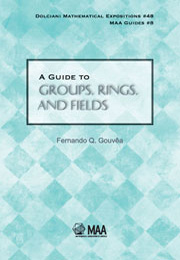6 - Fields and Skew Fields
Summary
This chapter studies the theory of division rings, i.e., fields and skew fields. To do that, we deploy both group theory and ring theory as developed in the previous chapters.
FIELDS AND ALGEBRAS
We begin by repeating the definitions and setting up some standard notations.
Definition 6.1.1A division ring is a ring in which 0 ≠ 1 and every nonzero element has a multiplicative inverse. A noncommutative division ring is called a skew field. A commutative division ring is called a field.
The choice of the word “field” seems to be peculiar to English; in other European languages, the word chosen is the one corresponding to the English “body”: in French, for example, it is “corps.” Skew fields are “corps gauches” or “corps non-commutatifs.”
The best-known examples of fields are ℚ, ℝ, and ℂ, together with the finite fields Fp = ℤ/pℤ where p is a prime. The quaternions ℍ and their generalizations provide examples of skew fields. Homomorphisms between division rings are just ring homomorphisms. Division rings do not contain proper ideals, so such homomorphisms must have trivial kernel.
Theorem 6.1.2If D1 and D2 are division rings, every homomorphism D1 → D2 is injective.
In particular, given such a homomorphism we can always identify D1 with a subring of D2.
SOME EXAMPLES
It will be useful to have a few “standard examples” in hand as we proceed.
Information
- Type
- Chapter
- Information
- A Guide to Groups, Rings, and Fields , pp. 221 - 276Publisher: Mathematical Association of AmericaPrint publication year: 2012
